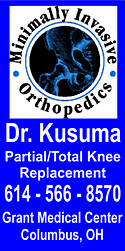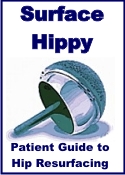Mobile Bearing Unicompartmental Knee Replacement
By
September 2007
When designing a unicompartmental knee replacement two conflicting requirements exist. To minimize wear it is necessary to have large contact areas so the contact pressures are small. This is best achieved by having congruous articular surfaces. Conversely to minimize loosening it is necessary to have low constraints and thus incongruous articular surfaces. This conflict is best solved by using a mobile bearing, which should prevent both loosening and wear.
Ideally, a mobile bearing should reproduce the function of the normal meniscus. The meniscus minimizes wear by having fully congruent contact in all positions with both the tibial and femoral condyles. As the condyles are polyradial and polycentric the meniscus has to change its shape to maintain fully congruous contact with the surfaces. An artificial mobile bearing cannot change its shape; therefore, to achieve fully congruous contact the femoral component must have a spherical surface and the upper part of the bearing must have a matching spherically concave surface. This is the key feature of the design of the Oxford Knee (Figure). A detailed overview of the Oxford Knee is given in a book written by the authors.
The Oxford Knee was first used bi-compartmentally. It was soon discovered that it only did well with an intact anterior cruciate ligament (ACL). It also was observed that if the ACL was intact then the disease was almost always unicompartmental. The device was then used as a uni-compartmental replacement when the ACL was intact.
The indications for the Oxford unicompartmental knee replacement are now well defined and have remained basically unchanged for 20 years. The main indication is medial compartment osteoarthritis, with full thickness cartilage laterally and functionally normal ligaments. Avascular necrosis also is an indication.
Few contraindications exist, and most of those proposed by other groups are ignored. Anterior knee pain and localized full thickness cartilage loss in the patellofemoral joint are indications. An ulcer on the medial side of the lateral condyle is not a contraindication. Age, activity, obesity, and chondrocalcinosis are ignored. As a result of implanting unicompartmental knee replacement in patients with these “accepted” contraindications data has been obtained about the outcome with these conditions. This data supports the view that these contraindications can be ignored. The limited number of contraindications allow for the procedure to be performed in approximately one in three patients requiring knee replacement.
Price and Svard2 recently presented 20-year results of the Oxford knee. In this series there were 683 unicompartmental knee replacements with no patients lost to follow-up. At 10 years 90% had good or excellent knee scores, and at 20 years the survival was 92%. This high survival at 20 years has important implications. It demonstrates that the mobile bearing unicompartmental knee replacement is a definitive knee replacement and is not a pre-total knee replacement (TKR). It also confirms that it is appropriate to ignore the “accepted” contraindications. The low failure rate because of wear or loosening confirms that the mobile bearing prevents wear and loosening. A very low failure rate was reported due to progression of arthritis. This suggests that a well performed unicompartmental replacement arrests the progression of the arthritis.
The device also is reliable in the young: the survival of patients >60 years is no different from those <60, up to 15 years. It was found that 30% of young patients had Tegner Scores of >5 (jogging on uneven ground). This suggests that the replaced knees function so well that the patients ignore the surgeons’ advice about restricting activity. Also as the long-term survival is good in this group of patients, high activity may not be a problem with a mobile bearing. Concern exists with a mobile bearing about dislocation, however a meta-analysis has shown that the dislocation rate is approximately 1 in 200.
In 1987, the Phase III Oxford was introduced. This had sophisticated instrumentation that simplified the operation and allowed the device to be implanted through a short incision. With the short incision, patients recover rapidly. The speed of recovery was twice as fast as after open unicompartmental knee replacement and three times as fast as after TKR. Long-term results with the small incision are not available, however the nine-year survival is 98%. At five years >85% have excellent Knee Society Objective scores. At five years the average range of movement is 133°, which is approximately 20° more than it was preoperatively. However, it still relates to the preoperative range of movement. In countries where patients have a good preoperative range of movement they recover full flexion by two months.
In the lateral compartment the results of mobile bearing unicompartmental knee replacement have been disappointing with a 76% survival at eight years. Therefore, its use is not recommended. However, the main cause of failure was dislocation, and the dislocation rate was approximately 10%. One of the reasons for dislocation is that in normal knees in high flexion the femur subluxes off the back of the convex tibial plateau. Therefore, a mobile bearing unicompartmental knee replacement has been developed with a convex tibial component. The short-term results with this device are encouraging: the dislocation rate is low and knee function is good.
Another interesting subgroup of patients are those with medial osteoarthritis secondary to ACL deficiency. If these patients are young and active and the deformity is correctable, I perform a combined unicompartmental knee replacement and ACL reconstruction. The results with this procedure are short-term but the clinical scores are very high.
Unfortunately, not every surgeon has been able to achieve good results: although most published 10-year series have survival rates >90%, not all do. This variability in results is also seen in the National Registers. Data from the Swedish Registry showed that centers performing more unicompartmental knee replacement had better survival rates. Data from the New Zealand Registry showed that surgeons performing greater numbers had better survival rates: surgeons who implanted at least 10 Oxford Knees per year had a very low failure rate (approximately 0.5% per year).
These variable results all were obtained with the same implant. They must, therefore, be a manifestation of variable indications or surgical technique. To address this problem we now run instructional courses and suggest that surgeons should only use the device if they are able to perform >10 per year.
Approximately 1 in 3 patients requiring knee replacement are appropriate for the Oxford Knee. With this device you can expect rapid recovery, excellent function, and good long-term survival even in the young and active. However, good results can only be achieved with appropriate indications and techniques.1
References
-
Goodfellow J, O’Connor J, Dodd C, Murray D. Unicompartmental Arthroplasty with the Oxford Knee. Oxford, England: Oxford University Press, 2006.
-
Price AJ, Svard UC. 20-year survival and 10 year clinical results of the Oxford medial UKA. Proceedings of: the 73rd American Academy of Orthopaedic Surgeons Annual Meeting; Chicago, Ill; 2006:538.
Author
Prof Murray is from Nuffield Orthopaedic Centre, Oxford, United Kingdom.
Correspondence should be addressed to: David W. Murray, MD, FRCS(Orth), Nuffield Orthopaedic Centre, University of Oxford, OX3 7LD, United Kingdom.



